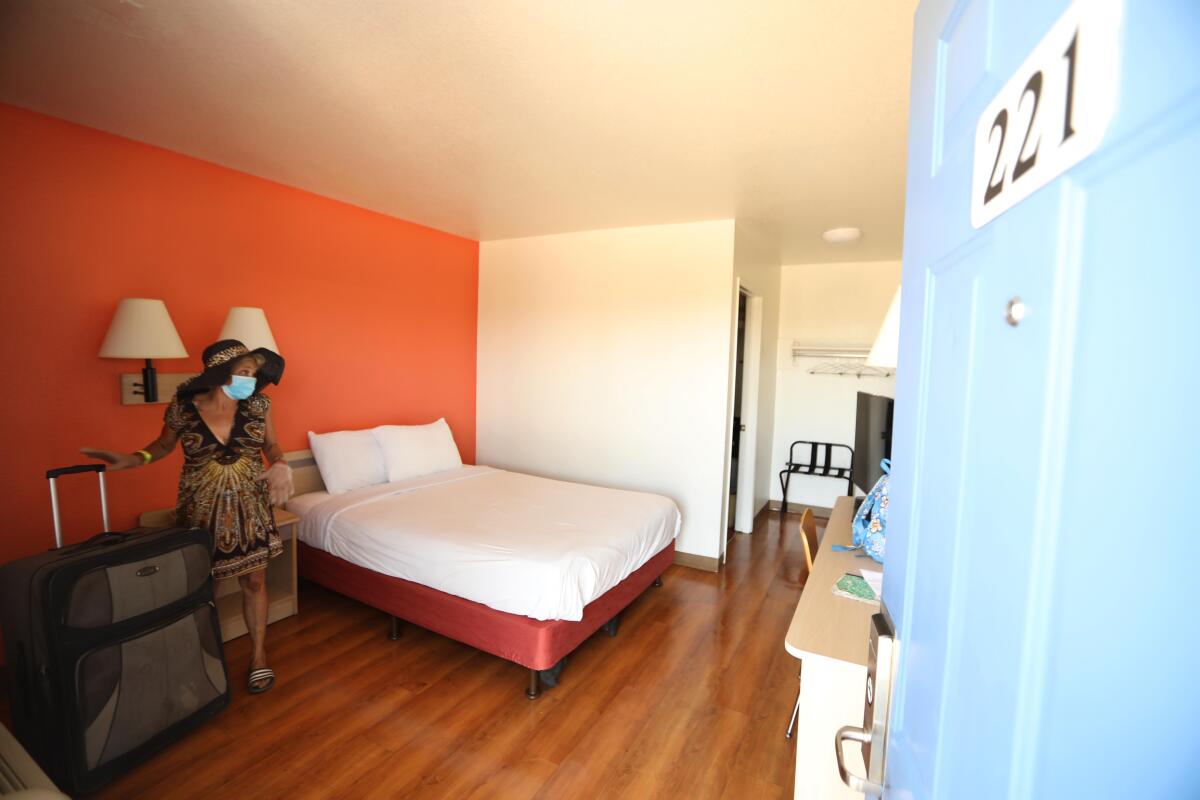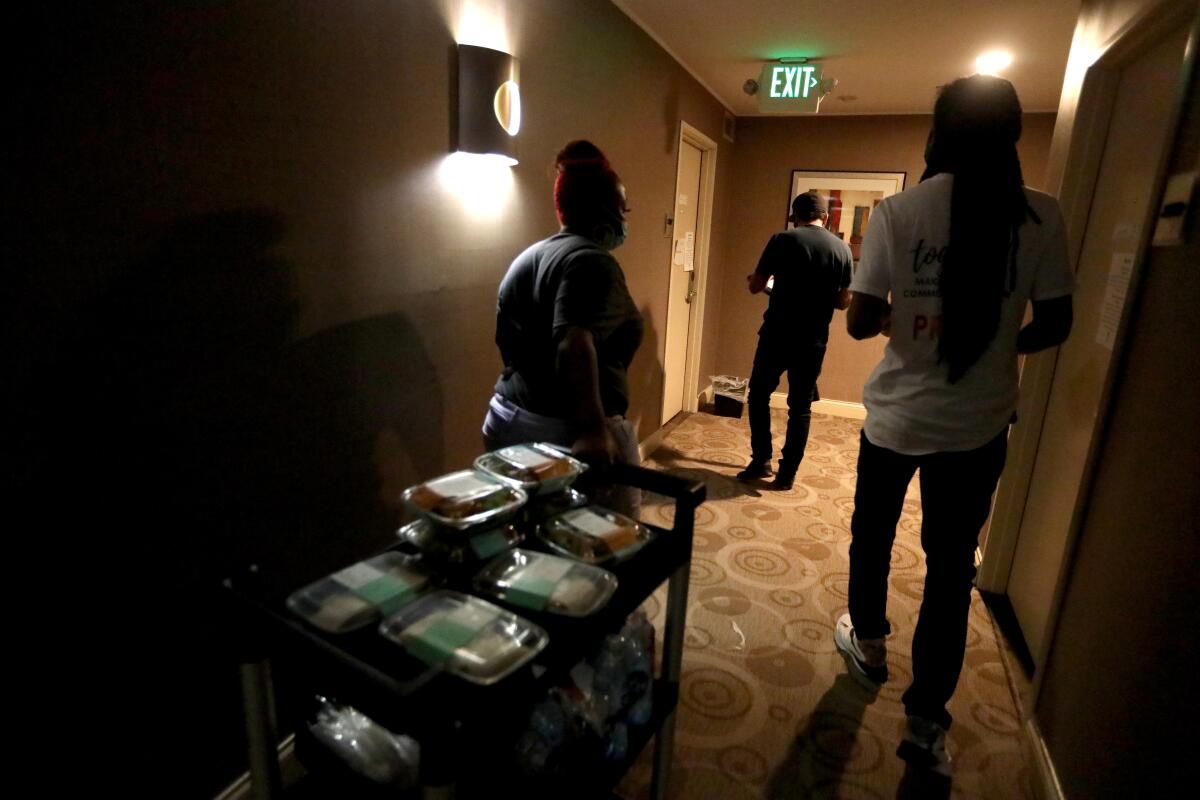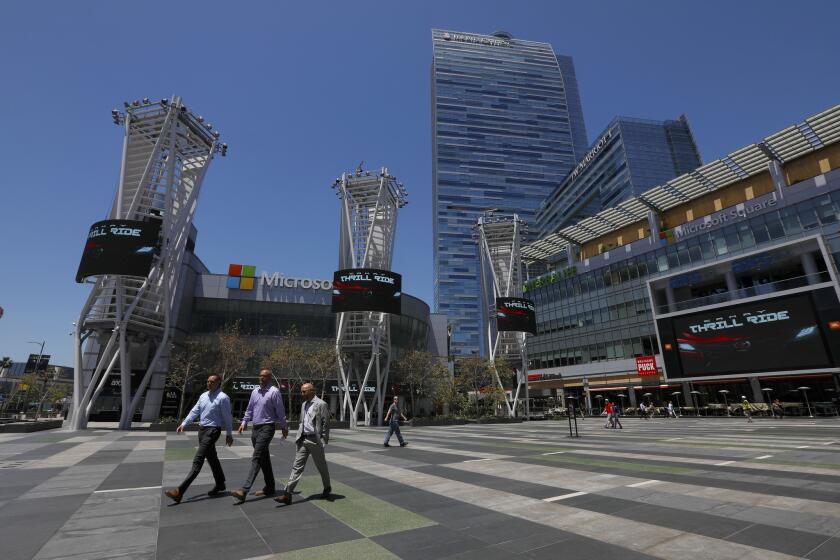Program to house homeless people in hotels is ending after falling short of goal

- Share via
One hotel emptied its rooms in late August. Another did so last week. A third is winding down this week.
It’s the beginning of the end for L.A. County’s Project Roomkey, the $100 million-plus program to repurpose hotels and motels emptied by the coronavirus as safe havens for homeless people.
After peaking at just over 4,300 guests — about 30% of its ambitious goal — the project will shed several hundred beds monthly until it closes down early next year, said Heidi Marston, executive director of the Los Angeles Homeless Services Authority.
The program is being squeezed by uncertain funding from the Federal Emergency Management Agency, which pays about 75% of its cost, raising the possibility of a sudden cutoff that would force the county to abruptly shut down hotels, Marston said in an interview.
Marston said LAHSA intends to transition the 4,000 people still living in hotels into other housing so they will not be forced to return to the street.
“Our first priority is those who are in the hotels,” Marston said. “We don’t want them exiting back to the street.”
The program, part of a statewide effort launched by Gov. Gavin Newsom, began in March with a goal of providing temporary housing for all of the 15,000 people in LAHSA’s records who were 65 or older or had chronic health conditions such as heart or respiratory illness — the Centers for Disease Control and Prevention’s benchmarks for those most vulnerable to hospitalization or death from COVID-19.
Its legacy will be mixed. By moving thousands of people off the street in record time, it was a stunning demonstration of what can be done, officials say. In some ways the county’s program outshone the state, quickly filling more than 90% of available rooms while statewide occupancy was slow reaching 50%.
The city’s report looked at hotels in L.A. that received taxpayer assistance or were built on city land. None of them took part in Project Roomkey.
But it also highlighted limitations of both funding and human capital to solve the county’s homeless crisis. As an initial surge of leases with hotel owners tapered off, it quickly became clear the program would fall well short of its goal and make no more than a small dent in the roughly 48,000 people estimated to be living on the county’s streets. It still faces a high bar in providing shelter or housing for all those considered highly vulnerable.
“There were aspects that I think were a huge success,” said Sarah Dusseault, who chaired LASHA’s governing commission through its early stages. “Housing that many people in a short period of time, I think that is extremely successful. Nothing on that scale has ever been attempted before.”
“There’s no example like it,” Supervisor Mark Ridley-Thomas said. “We have to be smart about the use of our resources, and so I say to you that this shows progress, and we need to replicate it. We need to build on it.”
Phil Ansell, head of the county’s Homeless Initiative, said the limiting factor was the number of hotel and motel owners willing to participate. Although the owners of more than 20,000 properties expressed interest, differences over price, qualms by insurance carriers and lenders, and concerns about branding turned out to be obstacles.
“Project Roomkey was an unprecedented undertaking in an unprecedented situation,” Ansell said. “We didn’t know how it would play out and that included not knowing how hotel and motel owners would respond to the opportunity.”
LAHSA and the county added their own impediment early in the program when they decided for efficiency to target only hotels of 100 or more rooms, eliminating some of the most eager participants.
Early concerns that providers of nursing, security and case management services would be unable to keep pace proved unfounded, Ansell said.
Though Project Roomkey imposed major demands on service providers, “we never turned away from a willing owner who had an acceptable price based on any concerns about capacity” to staff the hotels, Ansell said.
One homeless man’s four-month wait for an apartment, while it lay vacant, reflects a persistent failing of L.A.’s countywide system to get homeless people into housing — an especially critical need during the coronavirus pandemic.
But the inherent difficulty of working with unsheltered homeless individuals — who make up 73% of Los Angeles’ homeless population — was also evident. The rest live in different forms of interim housing, such as shelters.
Data on Project Roomkey provided to The Times show that just over a third of the roughly 6,600 people who checked into the 38 hotels and motels have moved out. Of those, 10% went to permanent housing and 3% went to another shelter. At least 20% went back to the street. Just over half of those who left were unaccounted for.
Marston characterized those numbers as similar to what occurs in interim housing generally, partly because of rules and schedules.
“For me, it was about the curfew,” Marston said. “You have to be in by 7 p.m. They get bored and lonely.”
Despite the difficulties, LAHSA has never abandoned its goal of getting 15,000 people indoors, a goal Marston said was based on the need, not an assessment of what was possible. It still faces a sobering financing hurdle. In June, the agency asked Los Angeles County for an additional $800 million it said would be needed to provide permanent placements for the most vulnerable people over three years.
The last point-in-time count, which was conducted in January, found that Los Angeles County had about 66,000 homeless people. With the leases now winding down, it will focus on ensuring that those living in hotels don’t get forced back on the street.
Marston said the agency has commitments of $50 million from the city and county, which will be enough to house about 4,900 people. The money, which comes from the federal CARES Act, must be spent by Dec. 31.

Marston said her agency is going to make an aggressive effort to recruit landlords to take homeless individuals on as tenants.
In addition, several hundred units of new homeless housing is expected across Los Angeles County through Newsom’s Project Homekey, which provides funds to purchase or master-lease hotels and motels. Los Angeles County has been awarded nearly $54 million to buy five motels, and funds for three more motels are expected to be approved by the state.
If they are, it would add a little over 600 new units to the county’s housing stock. As part of the requirements to use this money, the state said homeless people must be living in the motels within 90 days. Some of these motels are participating in Project Roomkey. Over the next year, several will be renovated and converted into permanent housing.
The city of Los Angeles and its Housing Authority have commitments for 11 properties and are negotiating for five more that would provide 842 units in total, the city administrative officer reported.
Still, Marston doesn’t anticipate there will be enough housing available to move everyone directly into permanent placements.
Already, some of the guests in the two Roomkey sites that closed had to be shifted to other locations.
The long-term housing plan depends on the completion of several thousand units of new permanent supportive housing that is either under construction or moving forward with funding from Proposition HHH, the city’s $1.2-billion homeless housing bond program.
Dusseault, the LASHA commissioner, said she has been encouraged by a new openness to innovative housing models, including shared housing and “pallet home” villages featuring tiny prefab houses.
“Our goal is to tap into the private sector and into the capacity we know exists,” Dusseault said. “That’s going to require new and creative partnerships to access a much greater range of landlords than we have in the past. I’m talking to private sector innovators all the time. I think there is only going to be more innovation to cut cost and time of construction.”
The schedule of Project Roomkey closings is still tentative, Marston said. The city and county, which have both negotiated leases, are working with LAHSA to make the withdrawal orderly.
The goal, she said, is to stop accepting new clients six to eight weeks before the close date and start intensive casework to have 50% of the guests out a month in advance. Anyone still in the hotel by the close date will be moved to interim housing.
“It does not shock me at all to learn that very few people are moving from Project Roomkey into permanent housing,” said
Legal Aid Foundation of Los Angeles attorney Shayla Myers.
“All that does is illustrate the fact that we do not have nearly enough permanent housing available for people.”
More to Read
Sign up for Essential California
The most important California stories and recommendations in your inbox every morning.
You may occasionally receive promotional content from the Los Angeles Times.













